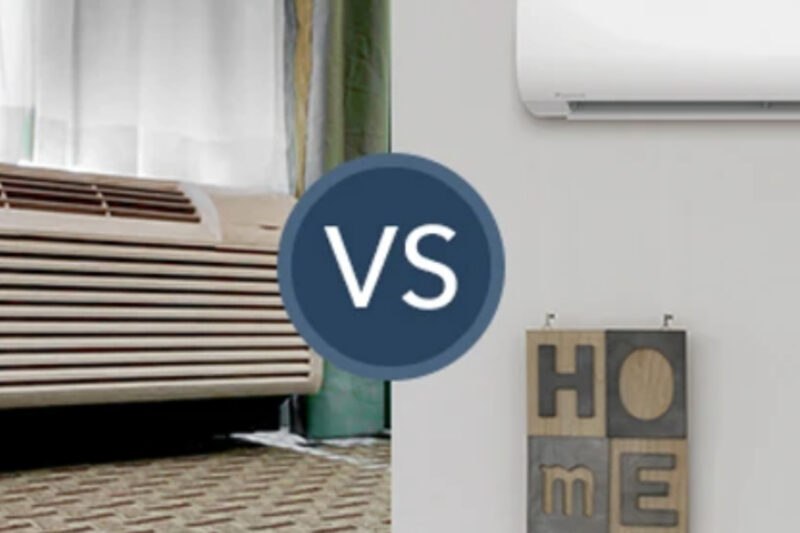It is not difficult to buy an air conditioner, let alone discover one that suits your needs. There are numerous options available, and you will not be disappointed. However, selecting the best cooling and heating system for a specific space in your home, office, or commercial complex is not always as simple as you might think. If you are looking for a perfect match for your comfort needs, budget, and personal preferences, knowing what the systems are can help you make a wise buy. In this post, we’ll look at two distinct systems that can both heat and cool a room with a single unit: PTAC Units VS Mini-Splits. For additional PTAC unit installation and HVAC assistance, please contact our PTAC installation specialists at (929) 447-2077.
What Exactly Is A PTAC Unit?
A packaged terminal air conditioner, often known as a PTAC, is a commercial-grade air conditioner that is placed through a wall. You’ve undoubtedly seen them in a hotel room when you’ve been traveling. So, what are the primary advantages of a PTAC?
Increased Efficiency: In the past, PTACs had a bad reputation for wasting energy. Manufacturers have worked hard in recent years to improve efficiency, making PTACs an excellent choice, particularly for hotels that must cool and heat several rooms.
Use Them All Year: Because they’re built for workplaces, hotels, and senior care facilities, PTACs have a heating feature. This may be an electric coil or a heat pump, but either way, you’ll have a year-round alternative.
Simple Install: When replacing an old unit, the unit can normally be inserted into the existing hole. If you are installing a PTAC for the first time, you will need to cut a hole, but most handymen or contractors can easily do this without the assistance of an HVAC specialist.
A Ductless Mini Split System Is What It Sounds Like.
An outside compressor/condenser and an interior air handler comprise a ductless micro-split system. A line set, consisting of a suction line and a liquid line, connects these two devices. These pipes are known as refrigerant lines because they transport refrigerant, which is an important heating and cooling component. A condensate drain line and an electrical wire connect the outdoor and indoor units.
If you use a centralized air conditioning system, a ductless mini split system does not require ductwork or a set of tubing that is installed and run throughout different rooms. This ductwork acts as a conduit for conditioned air before it is dispersed into the room via the air vents installed in each room.
The ductless micro split, like the PTAC, is reversible. It may work as an air conditioner in the summer and a heat pump in the winter. It can function in either mode, depending on the mode. Ductless mini splits are powered by heat transmission. Because of this heat transfer, the system functions as both an air conditioner and a heat pump. This is made possible by the use of liquid refrigerant in the system’s lines. During the process, this refrigerant moves and changes states cyclically. It would be condensed by either the compressor or the evaporator. As a gas, it transfers heat from the evaporator to the condenser; as a liquid, it transfers heat from the condenser to the evaporator. This cycle continues. Heat is absorbed and released.
Which Should I Get: A PTAC or a Mini Split?
So far, you’ve learned a little bit about both mini splits and PTACs; now it’s time to make a decision. Which is the best option for you? You should, in fact:
If you want multi-room comfort, go with a PTAC.
Because you can install a unit in each room, PTACs are excellent choices for delivering cooling and heating to hotels, dorm rooms, assisted living homes, and other facilities.
Cost Is An Issue.
In most cases, PTACs will be less expensive than micro splits. Attempting to build enough mini-splits to cool and heat a hotel will be far more expensive than installing several PTACs.
You Need Simple Comfort.
PTACs are typically low-maintenance. When you own a business property, time is money, therefore it’s critical to have a unit that doesn’t require continual downtime.
The Ease of Replacement Is Critical.
Because most PTACs are 42 inches wide, replacing old units with new ones is as simple as removing the old ones and putting in the new ones.
Select a Mini Split If:
- You own a home. Micro splits are superior solutions for residential settings for a multitude of reasons, including efficiency and aesthetics, because mini splits take up less wall space and blend in better than PTACs.
- Efficiency is an issue. Mini-splits will be more efficient than PTACs. Many types are energy-star rated, and because they are zoned, you can just chill and heat the areas you desire.
- Noise is important to you. In contrast to PTACs, where all of the components are present in the room. Because a small split compressor is situated outside, the only noise you’ll hear inside is from the fan.
- You’re not bothered by expert installation. While there are a few do-it-yourself mini splits available, the majority of types will require installation by a licensed HVAC specialist.
Additional Concerns
You’ve read our quick primer on PTACs and micro splits. Do you want to delve a little deeper? To learn more about these cooling systems, visit our ptac wall sleeve installation page.
Still unsure which model is right for you? Call us at (929) 447-2077 and ask about Problems Common With PTAC Units and other topics. We’re pleased to help you sort through the differences and find the most comfortable solution for your needs.



No Comments
Be the first to start a conversation